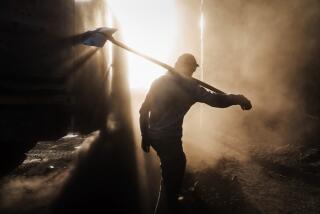Taliban Streams Out of Kunduz
BANGI, Afghanistan — Northern Alliance forces moved into the Taliban’s last stronghold in northern Afghanistan on Saturday as hundreds, perhaps more than 1,000, defectors poured out of the city of Kunduz and surrendered tanks, artillery and other weaponry.
At least some of those who surrendered were hard-line foreign Taliban, whose fate has been the focus of intense speculation and negotiation for days. At least a few of them turned out to be suicide bombers who had rigged their bodies with explosives and blew themselves up in Northern Alliance custody.
“They killed about five or six Northern Alliance commanders,” one opposition commander, Haji Mohammed Mukhaqiq, said by satellite telephone from Mazar-i-Sharif, alliance headquarters for the front line west of Kunduz.
It was unclear late Saturday whether the alliance had succeeded in capturing Kunduz. It was also unclear whether the advance followed an agreement on the surrender of non-Afghan Taliban fighters.
Many of the hard-liners are Arabs, Pakistanis, Chechens and other non-Afghans connected to Saudi militant Osama bin Laden’s Al Qaeda network.
Abdul Naser, a Northern Alliance spokesman in Taloqan, a city near the eastern front of the Kunduz pocket, said that “local Taliban want to surrender, and the foreign Taliban do not. They want to fight to the death.”
Secretary of Defense Donald H. Rumsfeld has said that the United States would oppose an outcome to the Kunduz standoff that would permit the foreigners to escape any fate other than death or capture.
In talks in recent days, Taliban hard-liners asked for safe passage to join their comrades in the movement’s other remaining stronghold, its spiritual center of Kandahar in southern Afghanistan. But Northern Alliance officials have said that would be unworkable.
New fighting was reported Saturday between Taliban forces and ethnic Pushtun tribal groups in southern Afghanistan, increasing the pressure on Kandahar.
Spokesmen in Washington and at U.S. Central Command headquarters in Florida said Saturday that they had no figures on how many Taliban troops had surrendered near Kunduz, and could provide no information about who now controls the city.
“The situation in Kunduz is fluid. It’s evolving,” Pentagon spokesman Marine Lt. Col. Michael Humm said in Washington.
“With regard to prisoners, it is very difficult for us to provide information right now,” said Central Command spokesman Marine Capt. Robert A. Riggle Jr. “There is no way for us to know” how many have surrendered, he said.
Northern Alliance leaders have said that although they are prepared to release fellow Afghans who fought with the Taliban, they want to deal more harshly with the foreign Taliban troops.
That has created a dilemma for the United States because many of the foreign fighters are from Pakistan, which wants to avoid a blood bath. The United States wants to assist Pakistan because of its agreement to support the war on terrorism, but so far, American officials have backed the Northern Alliance position.
Alliance Forces Reportedly Enter City
Mukhaqiq said the alliance sent forces into Kunduz from the south and the east and had entered the city. He could not provide details of the fighting or say whether the city was fully under control of the Northern Alliance. He estimated that the number of Taliban forces in the city, said in recent days to be as high as 30,000, had fallen to less than 12,000.
After conducting intense bombardment Friday, U.S. warplanes kept their distance from Kunduz on Saturday, with no visible signs of bombing or even aerial surveillance.
Instead, the day was marked by defections that suggested support for the Taliban was still hemorrhaging.
In the midafternoon on the eastern front, a convoy of two dozen vehicles, including a tank and an armored personnel carrier, appeared on the horizon and plowed toward Northern Alliance lines, spewing brown dust and gray exhaust into the chilly afternoon haze.
Excited Northern Alliance troops greeted the approximately 300 defectors by cheering and raising their weapons in salute. The two armored vehicles had been hastily decorated with posters of assassinated Northern Alliance leader Ahmed Shah Masoud, who is deeply revered by members of the alliance.
“I don’t think anyone will be left [in Kunduz] tomorrow except the foreign Taliban,” said the tank driver, 26-year-old Mohammed Akbar. “Everyone else will surrender.”
Afghan Defectors Ready to Join the Opposition
The defectors, many of them from local provinces, were allowed to keep their weapons in part so they would be prepared to join an upcoming battle on the alliance’s side, according to commanders at the scene.
“This is my city, my people, my relatives, so I surrendered from the Taliban to the Northern Front,” said Gulmeer, commander of the armored personnel carrier, who like many Afghans uses just one name.
Defections are an integral part of Afghan warfare. Commanders often maintain ties to others on the opposing side and switch sides according to clan ties or the shifting fortunes of war.
Fighters such as Gulmeer said they do not consider such defections a betrayal. He also said that at this point, there is no going back. His fate is in the hands of the alliance.
“If the [Northern Alliance] tells me to stay at home and get a job, I will stay at home. If they tell me to fight the Taliban, I will fight the Taliban,” he said. “Anything the Northern Alliance wants to do with me, I am ready to accept.”
Gulmeer said the recent U.S. bombing had severely weakened the Taliban in Kunduz.
“The bombing has been an essential element in getting the Taliban to surrender. It was very intense, and we were faced with a very bad situation,” he said. “We didn’t have any choice except to surrender.”
On the western side of the Kunduz pocket, as many as 1,000 Taliban fighters turned in their weapons, Mukhaqiq said, and were being held in the village of Qala-i-Jangy, which has a large prison. He said he did not know how long they would be held there or what their fate might be.
Some observers fear hatred of the foreign Taliban runs so high among the Northern Alliance that Taliban prisoners may face mistreatment or even summary execution, both of which are prohibited under the Geneva Conventions.
Among those killed by the suicide bombers was Nader Ali, the Northern Alliance security commander of Balkh province, which includes Mazar-i-Sharif, Mukhaqiq said.
In southern Afghanistan, about 800 fighters loyal to influential tribal chief Hamid Karzai and a second force under Gul Agha Shirzai, a tribal leader who commanded anti-Soviet moujahedeen forces in the 1980s, were engaged in heavy fighting with the Taliban along a main road leading from Kandahar to the border with Pakistan, Karzai’s brother, Ahmed, said.
Ahmed Karzai said his brother’s forces had cut the road from Kandahar to the border town of Spin Buldak near Takhtehpol. There was no independent confirmation.
American Airstrikes Hit Southern Targets
As the Pushtun fighters attacked the Taliban on the ground, American warplanes reportedly hit the Islamic movement’s forces from the skies.
“Helicopters were firing at us,” Najibullah Akhund Shirzai, the Taliban chief of security for Spin Buldak, said in a telephone interview late Saturday. Ahmed Karzai also said that he had been told by Pushtun commanders that there was heavy American bombing of the Taliban forces.
Taliban reinforcements were being rushed to the fighting from Kandahar and Spin Buldak, the Taliban security chief said. By late Saturday, there were few Taliban soldiers, other than watchmen, left in Spin Buldak.
Pushtun Opposition Seems Unsure of Plan
Although the outcome of the current fighting is in doubt, the Taliban troops are escaping slowly, the security chief said, suggesting that even in the south, they no longer feel duty-bound to fight to the end.
But the Pushtun fighters do not appear to have a clear follow-on strategy. Lacking food and in need of rest, they were planning to take a day to recover before making their next move, Ahmed Karzai said. Then they will move south to secure the area of Kandahar province bordering Pakistan, or turn north toward Kandahar.
A move to the north would be far more dangerous because they would go up against the bulk of the remaining Taliban troops. There are large numbers of Taliban in Kandahar who have fled there from elsewhere in the country.
*
Reynolds reported from Bangi, and Rubin from Quetta, Pakistan. Times staff writer Peter G. Gosselin in Washington contributed to this report.
More to Read
Sign up for Essential California
The most important California stories and recommendations in your inbox every morning.
You may occasionally receive promotional content from the Los Angeles Times.










